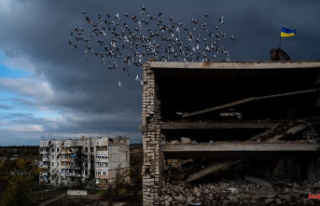Tomato soup splatters on a van Gogh painting protected by glass. At a congress with the Chancellor, a climate protection group set off a false fire alarm. Activists have already stuck themselves in Christian Lindner's Ministry of Finance, as well as on busy streets. The protest researcher Jannis Grimm teaches at the Freie Universität Berlin and explains to ntv.de why climate activists want to disrupt and their actions are smarter than many think.
ntv.de: The climate activists get a lot of scolding from society, especially for their museum campaigns. Is sticking to the minister legitimate, but not soup on European cultural assets?
Jannis Grimm: First of all, protests can only be effective if they have a certain disruptive potential. Protests that take place within a well-defined framework are unlikely to be effective unless large masses are mobilized. What all these actions have in common: they are very disruptive, they disturb, irritate, provoke - in times when the public has almost gotten used to other forms of climate protest, so they hardly attract any attention.
The paintings were protected by glass, so they were not damaged. Nevertheless, "Modder auf Meisterwerk" seems to hit a nerve.
Such an attack actually generates a lot of attention, because classical works of art in particular are accepted and recognized as cultural assets across political borders and social divides. When it comes to how far activists go, there are big differences: in Italy, for example, some protesters cling to real masterpieces like the statue of Laocoon, in London they just cling to a copy of Da Vinci’s Last Supper . The degree of actual damage to the objects also varies. It is not scientifically possible to assess the extent to which such a form of protest is legitimate in our society. It is ultimately up to the viewer. And that is also the crux of these actions.
Because they often cause anger in society?
They are seen by some as no longer legitimate, by others as a step that is overdue. This is what makes these forms of protest so ambivalent.
When it comes to the museum attacks, many people complain that the works of art have nothing to do with climate change. Do road blockades make more sense then?
When civil disobedience takes place on the streets, the connection between climate and combustion engines as contributors to climate change is very obvious.
Less for paintings, even if it is oil paint.
Anyone who looks at the affected pictures, such as Monet, understands the symbolism immediately. This painted field landscape, exhibited in a museum, is in reality massively threatened in Europe by drought and heat. She threatens to disappear. This also applies to Vincent van Gogh's sunflowers, which dried up everywhere in France this summer due to the drought. In addition, museums are accepted as places of education that preserve beautiful things, ultimately world heritage. This is how some protest groups put it: museums should not only aim to preserve the past, but also to be oriented towards the future.
And shouldn't we as a society, according to the activists, enjoy the beautiful landscape motif if we let the real landscape that served as a model die?
That's one level. On a second level, these museum actions often contain a critique of materialism, of a society that focuses on consumption or objects - in this case works of art - but at the same time is built on the exploitation of the environment. The statement should then be that these goods will ultimately be worth nothing when society has destroyed itself.
But doesn't that ultimately apply to all goods when you put them in relation to the destruction of the planet? The number of people at risk of starvation worldwide has skyrocketed from 27 to 41 million in two years. On the other hand, what still holds? In the end, does such a threat legitimize any form of protest that does not cause physical harm?
The end never justifies all means. Conversely, the means and tactics largely determine whether protesters are listened to and demands taken seriously. But they also determine whether you sit down at a table with activists or put them in a corner with violent radicals.
What the protesters are doing, whether with soup or superglue, is called "civil disobedience." What does that actually mean?
Civil disobedience is defined as a calculated violation of the law. This breach of the law is very central, at the same time the person holds tight to the system in which this right takes place. And she refrains from violence against people.
The radical protest groups are often accused of being anti-democratic in their forms of action. Just recently, a judge said that in his verdict against an activist. Is civil disobedience anti-democratic? Or are there differences - sometimes yes, sometimes no?
Anti-democratic - no, because the protesters affirm the system and demand that the solutions be delivered by elected political decision-makers. There is no general renunciation of a normative democratic regulatory framework, but there is a deliberate breach of the law to prompt the same to act. He can be convicted in court, he will be punished, and that is taken into account. The protesters consciously accept being judged on the basis of criminal law.
So far, the assessment in society seems to be clearly going against the activists. Not everyone is still aware that the paintings were protected behind glass. Such actions harm the issue of climate protection more than they help?
One of the activists' arguments is that the window of opportunity to fight climate change is closing. And if nobody provides answers now, then you just have to start getting uncomfortable. When in doubt, you have to offend people in order to put a topic on the agenda that would otherwise not be sufficiently discussed.
"Offense" - good cue. Many reactions to the museum attacks sound like this: We supported you, we actually supported your goals. But if you start destroying our values now, then the fun stops.
You can reject these actions and still say that climate change is a huge problem, but this is not the right way to fight for climate protection. I very much doubt that because of radical actions, such people will say that the climate is no longer important. Protagonists of these actions often ask why media outrage at symbolic property damage is greater than outrage at how many victims of climate change are already experiencing so much suffering.
That brings us back to the 41 million starving people and the question of what means of protest make them seem legitimate.
I believe that the assessment of these actions has not yet been conclusively done, that many people have two hearts beating in one breast - on the one hand, the goals are very understandable, on the other hand, the methods are problematic, because protecting cultural property is also important. Such actions do not necessarily have to resolve the contradiction, but it is incredibly productive to generate attention.
Are there any findings as to whether the motives are understood?
So far there is hardly any reliable data on this question, but there is at least one survey by the "Tagesspiegel" related to blockade actions in Berlin's city traffic. 60 percent of those surveyed cannot understand the protest, while more than a third of Berliners do not see it that critically.
In this respect, can it benefit the actors if society gets used to the noise a bit? Because - after the first outrage - she might start to look more closely at the motives of the boys?
The routine with which such protests are now being carried out - in Munich, in Dresden, in Berlin - means that local politicians, for example, have to react to them in the medium term. This does not mean that you sit down with the authors and look for a solution. However, moderate climate protectionists can benefit from the publicity created by groups such as "Extinction Rebellion" or "Last Generation". They then profile themselves as a more professional alternative and are understood as legitimate contacts.
That sounds like a form of division of labour.
This can develop, even if that was often not intended at all. But it can be seen in many movements worldwide. The moderate actors use a kind of "radical flanking effect". Groups like "Extinction Rebellion" or the "Last Generation" are not primarily concerned with getting approval for their organization. With their disruptive actions, they want to put climate change on the agenda at a time when it is threatening to disappear from the agenda.
Frauke Niemeyer spoke to Jannis Grimm












